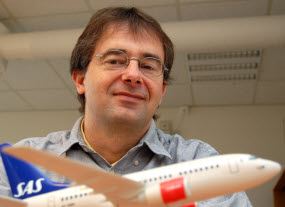
|
|
Project manager Jan Erik Håkegård of SINTEF ICT is helping to develop a communication system that will encompass all exchanges of data and reports between the airport and aircraft on the ground. Photo: Svein Tønseth |
This year the Trondheim scientists are launching a new project in this package.
Exchanging data and reports at airports
SINTEF will be contributing to the first European wireless communication system to embrace all exchanges of data and reports in airports – to and from aircraft on the ground before take-off and after landing.
The aim is to make the flow of information at busy airports so much more efficient that it will be easier to get planes into the air on schedule.
Projects worth NOK 150 million
Including the work involved in this new joint European system, SINTEF has been awarded air transport projects worth a total of almost NOK 150 million in the course of only a year.
These projects will run for up to six years, and form part of a major EU-supported ICT programme aimed at streamlining European air traffic.
The joint European effort will give air-traffic controllers new intelligent information systems, which will get aircraft to their destinations faster and more punctually, even more safely, and with lower, and thus more environmentally friendly, fuel consumption than today.
Shorter routes
The international designation for this type of operation is Air Traffic Management (ATM).
Europe's main goals on the ATM front are to be able to provide aircraft with new, shorter routes, and to cut down the queues that currently build up in the air on the way to major airports. This demands new forms of air - ground communication with a high capacity for data exchange.
Queues on the ground mean queues in the air
“However, how far it will be possible to reduce queues in the air depends a great deal on how rapidly and punctually aircraft can get away from the gate. And this in turn is closely related to how efficiently data and reports can be exchanged between everyone involved at the airport while the plane is still on the ground,” says SINTEF's Jan Erik Håkegård.
The senior scientist, who is leading SINTEF's part of the airport project, is emphatic that this aspect of the work also concerns making traffic in the air more efficient.
See also: SINTEF to carry out measurements in Madrid
Greater capacity – better security
SINTEF's new contract is worth €1 million (NOK 8 million), including the research foundation's own share of the funding package. SINTEF will develop the new ICT system in collaboration with industrial and academic groups from Spain, France, Italy and Ireland, as well as the European air transport body Eurocontrol.
By Svein Tønseth
